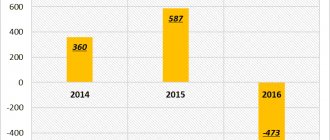WC (Working Capital, NWC, Working Capital, Working Capital, Own Working Capital) is the company’s money that it can use to finance its core activities.
The indicator is used by investors to determine the company's financial stability and financial stability. In simple words, working capital (WC) shows whether the company will be able to pay off short-term obligations and use money for its development.
Take our proprietary course on choosing stocks on the stock market → training course
Standard values
Working capital must be greater than short-term liabilities. Otherwise, there is a risk of bankruptcy. However, if there is an increase in working capital over time, then this means the accumulation of accounts receivable, which is part of current assets.
Working capital management is based on controlling its value in such a way that, on the one hand, the company has the opportunity to conduct operational activities, and on the other, there are no problems with financial stability. To determine the optimal value, optimization is carried out.
When optimizing working capital, they usually work with processes affecting: Production and Inventory, Sales and Accounts Receivable, Purchases and Accounts Payable.
Optimization of working (working) capital. Photo: biconsult.ru
The concept of working capital
Net working capital is the proportion of current assets financed from long-term financial sources. The value of this indicator is defined as the difference between the current assets of the enterprise and its short-term liabilities. Current assets are understood as cash and property that are converted into money during one production cycle or year, and short-term liabilities are the debt of the company, which must be returned to creditors within a year.
In essence, working capital reflects the company's potential cash reserve - part of the current assets that remain with the organization in a situation of full payment of existing current debts, or a margin of financial strength that allows the company to operate normally without fear for the reliability of the company even in the most critical circumstances.
The optimal cost of working capital is established in accordance with the characteristics, specifics and needs of a particular enterprise. It depends on many factors: the scale of activity, the turnover period of inventories, debtors' debt, conditions for granting loans and credits, etc.
Calculation example using Colgate-Palmolive according to IFRS
Let's calculate working capital according to the international financial reporting system (IFRS) for Colgate-Palmolive (CL). Let's take the annual reports from the company's website in the section for investors. In the consolidated report, we take the value of Current Assets and Current Liabilities. Also, do not forget that the data in the balance sheet is presented in “millions”, i.e. then add 6 more zeros.
Working Capital (WC) calculation for Colgate
We enter all the data and get the value for Colgate for 2021 of $141,000,000.
Average annual cost of fixed assets. Definition and regulatory framework
A distinctive feature of fixed capital assets is their longest operational period. This period is many hundreds of times longer than one operational production cycle. In the field of accounting, entrepreneurs are helped by depreciation deductions, which help “spread out” the cost of the machine for each unit of product produced with its help. But what should you do if you need to make a certain cut into the existing property situation in the company?
Here, the annual average cost of fixed assets helps out. It reflects the actual total current value of the firm's capital. And the company may be interested in such an assessment for the following reasons:
- To assess the actual amount of costs that were incurred to maintain or restore fixed assets during the reporting period.
- Confirmation of the correctness of the legal (legal) registration of expensive capital assets and all transactions with their participation.
- Accounting for sales and write-offs.
- Recording possible losses associated with the ownership and operation of fixed assets.
- Assessing the efficiency of using fixed capital in core production activities.
The documents of the regulatory framework that enjoy well-deserved respect are the following:
- Accounting Regulations No. 6/01 “Accounting for Fixed Assets” No. 26-n;
- Methodological manual on fixed assets No. 91-n.
The state has a vested interest in the existence of a single standard for determining the average annual cost. After all, the amount of property tax collected depends on this. Therefore, the rules and calculation algorithm are directly spelled out in the following regulatory documents:
- Article 376 of the Tax Code of the Russian Federation;
- Letters from the Ministry of Finance No. 03-05-05.
Calculation example using PJSC Magnit according to RAS
Let's look at how this indicator is calculated using Magnit (MGNT) as an example. Let's take public reporting from the company's website. Do not forget that the data is in thousand rubles, then you will still need to add 3 zeros.
Calculation of Working Capital (WC) for PJSC Magnit according to RAS (1)
Calculation of Working Capital (WC) for PJSC Magnit according to RAS (2)
We will need two lines from the Balance Sheet: Current Assets and Current Liabilities. Let's calculate working capital for 3 years. Working capital has remained virtually unchanged over the past two years.
For 2021, Magnit’s working capital was equal to RUB 30,422,373,000.
Which line of the balance sheet contains the equity indicator
Calculating equity capital in the balance sheet using the Ministry of Finance method is a procedure that involves using data from the following sections of the balance sheet:
- lines 1400 (long-term liabilities);
- lines 1500 (current liabilities);
- lines 1600 (assets).
Also, to calculate equity capital, you will need information showing the amount of debts of the founders of a business company (let’s agree to call them DOO), if any (they correspond to the debit balance of account 75 as of the reporting date), as well as deferred income, or DBP (account credit 98 ).
The structure of the formula by which net assets and at the same time equity capital in the balance sheet are determined is as follows. Necessary:
- Add the indicators along lines 1400, 1500.
- Subtract from the number obtained in paragraph 1 those that correspond to the credit of account 98 (for income in the form of assistance from the state and gratuitous receipt of property).
- Subtract the debit balance of account 75 from the number on line 1600.
- Subtract the result obtained in step 2 from the number obtained in step 3.
Thus, the formula for equity capital according to the Ministry of Finance will look like this:
Sk = (line 1600 – DUO) – ((line 1400 + line 1500) – DBP).
Main capital
The production process, in addition to the labor of the labor force employed in it, occurs with the help of means of labor and objects of labor. Fixed capital is classified as means of labor. These are machines, equipment, devices, etc., necessary in production. Means of labor, influencing objects of labor (raw materials, materials, etc.) with the participation of the human factor, create products. Means of labor, if we talk about fixed capital in the form of buildings and structures, also create conditions for the production of products.
How to conduct an inventory of fixed assets ?
The structure and composition of fixed capital depend on the specifics of production and the market sector to which the enterprise belongs. An agricultural enterprise and an industrial enterprise will have a significant difference in the composition of fixed capital. Industry characteristics (crop production, livestock production, industry), the size of the enterprise, the composition of products and many other factors also play a role. Fixed capital is structured depending on the purpose of the study.
The most commonly used characteristics are the following:
- Production and non-production facilities. They differ in their use in the production cycle or for the purposes of cultural and consumer services for enterprise employees. Example: a workshop building is classified as production assets, and a club building on the balance sheet of the enterprise is classified as non-productive.
- Movable and immovable property. Example: a plot of land is real estate, and machines are movable property.
- Role in production. Here we are talking about whether the property is directly involved in the production process or creates conditions for it. Example: equipment directly, actively participates in production, and the workshop building participates passively, creating conditions for work.
What are the ways to replenish working capital ?
Classifications are also used:
- by type (indicating the share of each type, example: separate buildings, structures, equipment);
- technological (similarly, the share of a separate subgroup within a group, example: the share of special vehicles in the vehicle fleet);
- structure based on time of use (so-called age), etc.
Having studied the composition and structure of fixed capital, we can come to the conclusion that it is used in production many times, while being subject to wear and tear. Depreciation expressed in monetary terms is called depreciation. This value is included in the cost of manufactured products. The basic concepts when calculating depreciation are the original cost and the depreciation rate. At the same time, in accounting and tax accounting, methods for calculating depreciation may differ.
In both types of accounting, there is a linear method for calculating depreciation, which is most often used in practice. The calculation is carried out according to the formula A = Ps * Na , where Ps is the initial cost of the object, and Na is the depreciation rate. In this case, Na = 1/n * 100%, where n is the number of months of useful use of the object, determined according to the Classifier approved by the Government (Regulation No. 1 of 1/01/02).
Besides this method:
- in NU they use nonlinear (only for certain groups of objects, in accordance with Article 259.2 of the Tax Code of the Russian Federation, clause 5);
- in BU they use the reducing balance method in proportion to the useful life, in proportion to the volume of production (PBU 6/01 clause 18).
Accelerating depreciation factors may be applied.
Owners of fixed capital strive to ensure that its value is repaid until it wears out physically (actual unsuitability for further use, loss of useful properties) or moral, cost (loss of value due to progress, the creation of new equipment).
Technological progress leads to the need to legislate accelerated methods and standards for depreciation of equipment and machinery. Depreciation periods are reduced.
On a note! In addition to the term “fixed capital”, the concepts of “fixed assets” and “fixed assets” are used as synonyms in accounting. The terms “working capital” and “working capital” are used similarly.
Sources of working capital financing
From the point of view of choosing a source of financing in the working capital of an enterprise, its constant and variable parts are distinguished. The permanent portion is usually financed through long-term debt or equity. In turn, its variable part (for example, seasonal or unexpected needs) is usually financed through short-term sources of debt financing.
- Short-term loan. If a company has a temporary need for additional working capital, a short-term loan (repayment period less than 12 months) is a convenient source of financing.
- Credit line. If the need for additional financing cannot be predicted in advance, a credit line can satisfy it in a short time.
- Factoring. The disadvantage of this source of funding is its high cost, but it can be used when other sources are not available.
- Trade receivables. If an enterprise has a reliable business reputation, its management may ask suppliers to increase the deferred payment, for example from 30 to 40 days. The downside to this source of finance is that an increase in trade receivables is not a good sign for other creditors.
- Financing from own funds. Retained earnings are a widely used source of financing additional working capital requirements. In exceptional cases, owners can provide additional funds by increasing the authorized capital.
An alternative algorithm for calculating the amount of own working capital
The formula discussed above is not the only possible one. In economic practice, quite often they use another calculation option using sections 1, 3 and 4 of the balance sheet. It looks like this:
SOK = KR + DP – VA,
where: KR – part of own funds reflected in the section “Capital and reserves”;
DP – long-term liabilities from section 4;
VA – non-current assets from section 1.
The company's equity has a significant impact on the amount of working capital. It is best to consider this dependence with an example.
Example 2
If an entrepreneur who decided to create a company limited himself to the minimum authorized capital provided for opening an LLC, he would have problems with working capital already at the beginning of his activity.
This is due to the fact that the authorized capital of an LLC allowed by law is minimally limited to 10,000 rubles, and this amount is clearly not enough to purchase raw materials, materials or goods, pay for retail or production space, or hire personnel.
A newly minted businessman would have to try hard to find resources to increase working capital
to the required level. A large amount of the authorized capital, on the contrary, removes a significant part of the problems at the stage of starting a business and allows you to fully finance all the current needs of a young company.
In addition to the authorized capital, the company's own funds also include reserve capital, additional capital, retained earnings and additional valuation made on non-current assets. For the 2nd calculation option, Section 4 considers the amounts of long-term loans, borrowings, accounts payable, estimated liabilities, deferred tax liability and other long-term liabilities. We can say that he is fully involved in the formula.
Next, you simply need to add up the data from the indicated articles of sections 3 and 4 and subtract from them the amount of fixed assets, intangible assets from section 1. The result of the calculation will be the amount of own working capital
companies.
To better understand both techniques, it is best to refer to the example described below.







